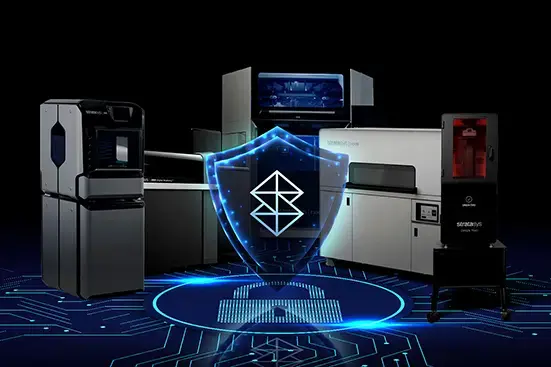3D printing isn’t just about prototyping anymore—it’s now a core element of industrial manufacturing, with printers embedded in factory floors, research labs, and defense environments.
But as the machines get smarter and more connected, they also become vulnerable. Intellectual property, production schedules, and operational continuity all rely on cybersecurity. If your additive workflows are compromised, your business can grind to a halt—or worse, leak sensitive data.
In this blog, we explore the key risks, the defense mechanisms Stratasys® has implemented, and what actions you can take to strengthen your own security posture.
|
Threat |
Description |
|
IP Theft |
CAD files, material selections, and build configurations represent valuable trade secrets. |
|
Network Intrusion |
Printers on unsegmented networks can be used as an entry point for attackers. |
|
Firmware Tampering |
Unauthorized changes to firmware could result in failed prints or worse—functional sabotage. |
|
Data Overcollection |
Some users fear “surveillance creep” as telemetry expands without clear opt-outs. |
|
Cloud Vulnerabilities |
Remote print prep, job queuing, and analytics are powerful—but also exposed. |
|
Compliance Gaps |
Regulations like GDPR, ITAR, or DoDI require strong safeguards, even in non-financial sectors. |
Cybersecurity is essential—but for industries where reliability and compliance matter most, information assurance is the broader goal. It means not only defending against attacks but ensuring the confidentiality, integrity, and availability of every data point in your 3D printing workflow.
Stratasys solutions are built with this mindset. From secure firmware and encrypted communications to offline modes and strict access control, our platform is designed to help customers maintain operational continuity, meet regulatory obligations, and safeguard sensitive data.
For customers needing certified secure manufacturing services, Stratasys Direct offers CMMC-compliant, ITAR-registered workflows built for defense and aerospace.
Whether you're operating in defense, aerospace, or any high-security environment, Stratasys gives you the tools to ensure trust—not just protection.
Stratasys follows a Secure Software Development Lifecycle (S-SDLC) and supports ISO 27001 standards. Its security approach is built on three pillars:
1. People & Process Controls
2. Product-Level Safeguards
3. Infrastructure Hardening
Stratasys software follows a modular approach built on a shared core. GrabCAD Print is the foundation, used by all systems for job preparation and execution. From there, users may add:
|
Product / Tier |
Security Features |
|
GrabCAD Print |
Local job prep with optional offline mode, no CAD data collection, user privacy settings, TLS encryption in connected mode |
|
GrabCAD Shop |
Secure cloud-hosted order tracking; role-based access (admin/operator/requester); job metadata stored in AWS S3 |
|
GrabCAD Streamline Pro Suite |
Enterprise-level control including: centralized user/device/license management (Control), usage dashboards (Analyze), and optional network hardening (Shield) |
|
FDM Systems (e.g., F3300) |
Hardware enclave controller, signed firmware, tamper-proof startup, and audit-capable logs |
|
PolyJet Systems |
WebSocket-based print telemetry; optional offline configuration; no CAD uploads |
|
Other GrabCAD-connected Printers |
Benefit from same platform-level protections as others: role-based access, data encryption, authentication via AWS Cognito, and optional offline operation |
As 3D printing systems become more powerful, their cybersecurity needs grow. Stratasys offers a security-first approach across software, hardware, and infrastructure—but ultimate security depends on how you configure and use those tools.
Importantly, cybersecurity is just one layer. At Stratasys, it's part of a broader commitment to information assurance—ensuring that your additive manufacturing workflows remain trusted, reliable, and compliant across their entire lifecycle.
Whether you're in aerospace, healthcare, or industrial manufacturing, your additive manufacturing setup must be as secure as it is sophisticated.
Take the time to evaluate your systems, leverage available safeguards, and choose partners committed to resilience, and transparency, and assurance.


